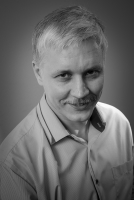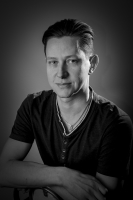Message from Olga A. Panchenko
President, KIWAMI
Project’s Mastermind

Vitaliy M. Vladykin
Vice President, KIWAMI
R&D GROUP
CEO, KIWAMI IT GROUP
After the first presentation, I immediately saw potential of the WAmetr project. You must agree that many people will want to buy an app that enables them to develop skills quicker and be in sight of the best coaches!
A simple and trusted system for self-evaluation of training progress would obviously be useful for beginner and professional athletes. Needless to say it would provide objective selection of the best candidates to teams and clubs!
Before joining the project, I had only one and the most important question - how realistic was the idea outlined in the presentation. I could not believe that no one in the world ever did that the way it was proposed.
It took me half a year to study the market of medical, sports, and fitness programs and to realize that nothing of that kind ever existed! Then I stepped in and offered my assistance in coding a small module.
It was surprising how easily Olga Panchenko, the mastermind behind the project, shared the idea. But when I delved into the WAmetr project, I realized what was behind such openness. Seemingly simple at first glance, the idea required combining expertise from different fields and creating a radically new analytical system.
As I learn more and communicate closer with other team members I get even more impressed by well-coordinated team activities, proper planning and management. This strengthens my belief in our success.
Amazingly how fast the project is developed, how effectively professionals from completely different areas of expertise find common ground and move forward in the same direction. Kiwami Group Services

Victor M. Oleinikov
Senior Database Expert
I heard about the idea of creating the WAmetr platform for real- time evaluation of the accuracy of movements based on the computer vision technology from my master Olga Panchenko in 2008 after one of Aikido trainings. She told me about efforts to create a system for correcting mistakes at the moment they were made.
It struck me immediately that it was a daunting idea, but many questions remained regarding ways of implementing individual elements, areas of application, benchmarks, and so on. I still keep the first database proposed.
Being well aware of the master’s perseverance, I dived into the topic. After thorough screening of all kinds of equivalent software and desktop and mobile apps, I was convinced that no one in the world ever offered any solution of such class.
The majority of existing software programs came short of hardware or they applied indirect and inaccurate measuring methods or their initial data analysis took from hours to weeks or they solved tasks that had nothing to do with effective and objective feedback in a ‘human-action’ system.
Now, I am proud that I have a chance to contribute to the realization of this idea. I am sure that our mobile app WAmetr. Perfect Posture will come out within timelines announced, while the WAmetr platform will open a new era of human development systems.

Vladimir A. Luzin
Chief Engineer, KIWAMI GROUP
I first learned about the idea of independent quantitative evaluation of accuracy of mastering Aikido techniques in 2003 from my friends who were trained by Olga Panchenko in the Aikido Club Hokkyokusei. Automated evaluation in martial arts seemed to me very exciting but completely impracticable since I was clueless how it could be materialized. Later on, I turned to the idea over and over again. Perhaps, that was the key factor why I joined the club in 2005.
Training techniques practiced in the club immediately resonated with my engineering self as logical, well-defined, and effective. The period of my training in the club saw changes in the training techniques three times. Each time it was a leapfrog that radically changed my views on effective conduct of a combat. They were not odd strokes of insight, but well-thought- out and reasonable actions of the club leader Olga Panchenko. I learned later that they were engaged in active and diversified activities on the development and implementation of the WAmetr platform.
Since 2003, the technology has moved far forward and the idea of real-time evaluation of the accuracy of movements has taken concrete shape. There is the flurry of new hardware available to the public. Over the past few years, a great variety of gadgets were created based on those hardware components. That is why we saw no challenge in terms of hardware. We just needed to pick up and chose the most suitable hardware out of the wide range available. Our first and most straightforward decision was to use an accelerometer and a gyroscope that could be found in the majority of modern smartphones. However, upon closer analysis, the accelerometer had very long response time for speeds we were dealing with, and both meters suffered from propagation errors. Moreover, it was not clear how to interpret data obtained. The second option was the use of the Sony play station with PS Move motion controller. But it turned out to be just a funny toy literally and figuratively.
Our further analysis of modern gadgets showed that there were no any out-of- the-box technical solutions to our problem, at least among those publicly available. The snag was how to find answer to a seemingly simple questio - how to identify from a live video stream a single shot that shows an extreme change of one or multiple key factors of a combat in real time, i.e. immediately. These factors should not be necessarily strictly obvious. To non- obvious factors may refer a change in acceleration of movement that neutralizes opponent’s actions. After much discussion and consideration, Olga Panchenko proposed a very exciting technology that allowed obtaining reliable data using simple hardware.
Very inspired at first, I implemented the idea in hardware and my training mate Victor Oleinikov wrote software. Later, as it often happens, we faced problems in interpreting raw data. Each of us tried to put a part of his work on the shoulders of the other. I was eager to add a signal coding scheme to the device, while Victor was not willing to overcomplicate the program by adding an additional module for obtained data recognition and decoding. Having failed to come to an agreement, we turned to our Sensei with the eternal question “What should we do?”.
After we put the matter before Olga, a shade of disappointment passed over her face. We realized that the problem is not that difficult indeed. Unwilling to upset our Sensei by negative results, we got to work on developing our own technical solutions. Eventually, we managed to get moving after we divided software in dispute into engineering and programmatic software. I am happy that our well-defined terms of reference helped us find the solution. They were so simple that, in chase of modern technologies, we did not even consider them in the first place. Truth be told, later after we solved the problem, we were told that the scientific community considered it unsolvable!
Currently, together with other Kiwami Group members we develop new devices and solutions to give a change to anyone from anywhere in the world to develop best skills using mobile apps that run on the WAmetr platform.
I like the idea that a man makes an informed choice of his own destiny.
A recipe for being a truly free man is hard work plus groundbreaking technology.
Good luck to all of us!



